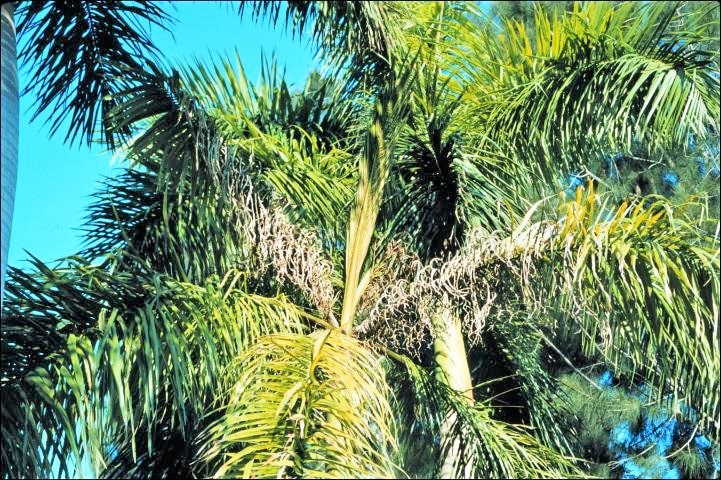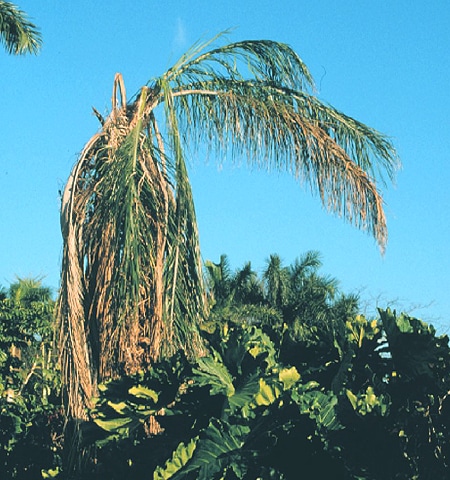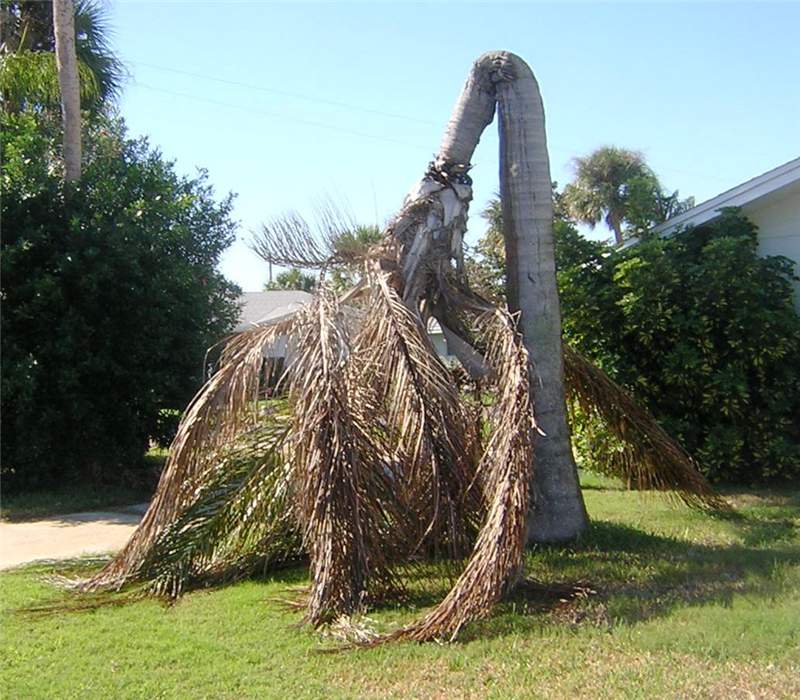Unveiling the Unique Challenges: Florida’s Palm Trees at Risk
Florida’s iconic palm trees, symbols of its lush landscapes and tropical allure, are facing unprecedented threats. These majestic plants, integral to the state’s identity, are under siege by a variety of diseases, each with the potential to decimate populations and transform the scenery. The challenges are unique and multifaceted, stemming from a combination of environmental changes, increased globalization, and the introduction of invasive species and pathogens. As these threats continue to evolve, the need for awareness and action becomes more critical.
The state’s warm, humid climate, while ideal for palm growth, also fosters the development and spread of numerous diseases. Among these, lethal yellowing, Ganoderma butt rot, Fusarium wilt, bud rot, and Texas Phoenix palm decline stand out as the most formidable foes. These diseases, each with its distinct symptoms and modes of attack, pose a significant risk not only to the individual trees but also to the broader ecosystems that depend on them. The impact extends beyond the environmental, affecting the economic and aesthetic value of Florida’s landscapes.
Addressing these challenges requires a concerted effort from homeowners, gardeners, landscapers, and professional arborists alike. Understanding the symptoms, causes, and preventive measures associated with each disease is the first step in safeguarding Florida’s palms. As the situation continues to unfold, the importance of staying informed and proactive cannot be overstated. The health of Florida’s palm trees is not just a matter of state pride; it is a critical component of its environmental resilience and aesthetic heritage.
Lethal Yellowing: The Silent Killer of Florida Palms
Lethal Yellowing (LY) is a devastating disease that poses a significant threat to many palm species in Florida, including the iconic coconut palm. This disease is caused by a phytoplasma, which is transmitted by an insect vector, the planthopper. The symptoms of Lethal Yellowing are often unmistakable and can lead to the rapid decline and death of affected palms. Initially, the fronds of the palm begin to yellow, starting with the older, lower leaves and progressively moving to the younger leaves at the top. As the disease advances, the fronds will wither and hang down around the trunk, and in coconut palms, the fruit may drop prematurely.
One of the challenges in managing Lethal Yellowing is its silent and swift progression, often leaving little time for intervention before the palm is irreversibly damaged. Early detection and treatment are crucial for the survival of infected palms. Treatment options include the injection of antibiotics such as oxytetracycline, which can help manage the disease but may not cure the infected palm. Preventative measures are also essential, focusing on the planting of resistant palm species and the management of the insect vector population to reduce the spread of the disease.
The impact of Lethal Yellowing extends beyond the loss of individual palms; it affects the aesthetic and economic value of Florida’s landscapes and properties. As such, understanding the symptoms of Lethal Yellowing, implementing preventative strategies, and seeking professional advice at the first sign of disease are vital steps in protecting Florida’s palm trees from this silent killer.

Ganoderma Butt Rot: The Hidden Foe Beneath
Ganoderma Butt Rot, caused by the fungus Ganoderma zonatum, poses a significant threat to Florida’s palm trees, often attacking without any visible warning signs until it’s too late. This disease targets the palm at its base, or “butt,” leading to the decay of the wood tissue and ultimately, the tree’s demise. Unlike other diseases, Ganoderma Butt Rot is particularly insidious because it leaves the upper parts of the palm seemingly healthy while it ravages the tree from below.
The first sign of Ganoderma Butt Rot is usually the appearance of a conk, a mushroom-like growth, on the palm’s base. This conk releases spores that can infect nearby palms, making the disease highly contagious. Unfortunately, by the time the conk appears, the damage to the palm is often irreversible. There is no effective chemical treatment for Ganoderma Butt Rot, making early detection and removal of infected palms crucial to prevent its spread.
Preventative measures include avoiding injuries to the palm’s base, as wounds can provide entry points for the fungus. Landscapers and gardeners are advised to sterilize their tools before moving from one tree to another to minimize the risk of spreading the disease. Regular monitoring of palms for early signs of the disease, such as unexplained wilting or the presence of conks, is essential for maintaining the health of Florida’s palm trees.
Given the lack of effective treatment options, the best strategy against Ganoderma Butt Rot is prevention and early intervention. Homeowners, landscapers, and arborists must work together to protect Florida’s iconic palm trees from this hidden foe beneath.
Bud Rot: The Moisture Menace
Bud rot presents a formidable challenge to the health and longevity of Florida’s palm trees, emerging as a critical concern for gardeners, landscapers, and homeowners alike. This disease, primarily caused by the Phytophthora and Thielaviopsis fungi, thrives in the moist, humid conditions characteristic of Florida’s climate. The initial symptoms of bud rot can be subtle, often manifesting as a discoloration or wilting of the younger, more tender fronds near the top of the palm. As the disease progresses, these symptoms become more pronounced, leading to the rotting of the heart or bud of the palm, from which the fronds emerge.
The impact of bud rot is not to be underestimated, as it can lead to the premature death of the palm if not addressed promptly. The disease spreads rapidly in conditions of excessive moisture, whether due to overwatering, poor drainage, or extended periods of rain. Prevention strategies are paramount and include ensuring proper drainage, avoiding overwatering, and implementing regular inspections of palms for early signs of disease. For palms already affected by bud rot, treatment options are limited but crucial. These may involve the removal and destruction of infected parts of the palm to prevent the spread of the disease to healthy tissue or neighboring plants.
Given the stealthy nature of bud rot and its potential for significant damage, proactive measures and early intervention are key to safeguarding Florida’s iconic palm trees from this moisture menace. Awareness and education about bud rot, its symptoms, and management strategies are essential for anyone involved in the care of palm trees in the region.

Texas Phoenix Palm Decline: The Lone Star Disease in Florida
The Texas Phoenix Palm Decline (TPPD) is a relatively new threat to Florida’s iconic palm trees, often referred to as the Lone Star disease due to its origins. This insidious disease is caused by a phytoplasma, a type of bacteria that lacks a cell wall, making it particularly difficult to treat and manage. TPPD is primarily known to affect the Phoenix species, including the Canary Island Date Palm, the true Date Palm, and the Sylvester Palm, among others.
One of the most alarming aspects of TPPD is its rapid progression and the lack of visible symptoms until the disease is well advanced. Infected palms may exhibit a general decline in health, premature fruit drop, or the death of the spear leaf, which is the youngest leaf at the top of the palm. As the disease progresses, all the leaves may wilt and die, leading to the inevitable death of the palm. Unfortunately, by the time these symptoms are noticeable, it is often too late to save the affected tree.
Prevention and early detection are crucial in managing TPPD. Homeowners and landscapers are encouraged to monitor their palms closely for any signs of decline and to implement strict sanitation measures to prevent the spread of the disease. This includes sterilizing pruning tools between uses and avoiding the movement of potentially infected material. While there is no cure for TPPD, infected palms should be removed and destroyed to prevent the spread of the disease to nearby healthy palms.
The introduction of TPPD to Florida poses a significant threat to the state’s palm population, highlighting the need for ongoing research, vigilant monitoring, and community awareness to protect these iconic trees from further decline.
Texas Phoenix Palm Decline: The Lone Star Disease in Florida
The Texas Phoenix Palm Decline (TPPD) is a relatively new threat to Florida’s iconic palm trees, having migrated from the Lone Star State. This insidious disease is caused by a phytoplasma, a type of bacteria that lacks a cell wall, making it particularly difficult to treat once infection sets in. TPPD is often mistaken for lethal yellowing, another deadly palm disease, due to their similar symptoms. However, TPPD primarily affects the Phoenix species, including the Canary Island date palm, edible date palm, and the wild date palm.
One of the first signs of TPPD is the premature dropping of fruits, followed by the discoloration of fronds, which turn from green to brown, starting from the lower fronds and moving upward. Unlike lethal yellowing, TPPD also causes the spear leaf at the top of the palm to die, a symptom that can help differentiate between the two diseases. If not diagnosed and managed promptly, TPPD can lead to the rapid decline and eventual death of affected palms.
Prevention and early detection are crucial in managing TPPD. Regular monitoring for symptoms, especially in susceptible palm species, is essential. Implementing proper sanitation practices, such as sterilizing pruning tools between uses, can help prevent the spread of the disease. Unfortunately, once a palm is infected, there is no cure, and it will likely need to be removed to prevent the disease from spreading to nearby palms. The role of professional arborists becomes critical in diagnosing and managing TPPD, as they can provide expert advice on prevention strategies and the safe removal of infected trees.

Preventative Measures: Shielding Your Palms from Disease
Preventing disease in Florida’s palm trees is crucial for their health and longevity. Understanding and implementing effective preventative measures can significantly reduce the risk of the common diseases that threaten these iconic trees. One of the first steps in disease prevention is selecting the right species of palm for your area. Opt for varieties known to be resistant to diseases such as lethal yellowing, Ganoderma butt rot, Fusarium wilt, bud rot, and Texas Phoenix palm decline. Proper planting and care are equally important; ensure palms are planted at the correct depth, and in well-draining soil to avoid waterlogging, which can lead to root rot and other moisture-related diseases.
Regular monitoring and maintenance play a pivotal role in keeping palm trees healthy. Inspect your palms frequently for any signs of distress or disease, such as unusual leaf discoloration, wilting, or trunk softening. Early detection of symptoms can be the key to preventing the spread of disease. Implementing proper irrigation practices is essential; over-watering can promote fungal growth, while under-watering can stress the tree, making it more susceptible to disease. Fertilization should be done carefully, using a balanced, slow-release fertilizer that meets the specific nutritional needs of palm trees, avoiding over-fertilization which can harm the tree and exacerbate disease susceptibility.
Lastly, sanitation around palm trees is critical. Remove and properly dispose of any fallen debris, including leaves and fruits, which can harbor pests and pathogens. Pruning should be done sparingly and with sterilized tools to prevent the spread of disease. By following these preventative measures, you can help shield your Florida palm trees from devastating diseases and ensure their health and beauty for years to come.
Treatment Strategies: Combating Palm Diseases in Florida
Addressing palm tree diseases in Florida requires a proactive and informed approach. Early detection and correct diagnosis are crucial steps in effectively managing and treating these conditions. For diseases like lethal yellowing, treatment often involves the injection of antibiotics such as oxytetracycline HCl directly into the trunk. This method, while not a cure, can suppress the disease’s symptoms and prolong the life of the affected palm.
Ganoderma butt rot, on the other hand, presents a more challenging scenario as there is no known cure once a palm is infected. The best strategy is to remove and destroy the infected palm to prevent the spread of the disease to nearby palms. Similarly, for Fusarium wilt and Texas Phoenix palm decline, the focus is on prevention, as these diseases are also incurable once the palm is infected. Implementing strict sanitation measures, avoiding the use of contaminated tools, and selecting resistant palm varieties when available are key preventive measures.
Bud rot, caused by both fungal and bacterial pathogens, can sometimes be treated by removing affected parts of the palm and applying fungicide or bactericide, depending on the pathogen involved. However, in severe cases, removal of the palm may be necessary.
It’s important for Florida residents to work closely with professional arborists who can provide accurate diagnoses and recommend specific treatment or management strategies. These professionals can also offer advice on preventive care to minimize the risk of disease. By adopting an integrated approach to disease management, including both chemical and cultural control methods, the health and beauty of Florida’s palm trees can be preserved.
The Role of Professional Arborists in Disease Management
Professional arborists play a crucial role in the management and control of palm tree diseases in Florida. Their expertise and experience are invaluable in diagnosing the specific diseases affecting palm trees, a task that can be challenging due to the similar symptoms presented by different diseases. Arborists are trained to recognize the subtle differences in symptoms and can provide accurate diagnoses, which is the first step in effective disease management.
Once a diagnosis is made, professional arborists can recommend the best course of action for treatment. This may include the application of fungicides, the removal of infected parts of the tree, or in some cases, the complete removal of the tree to prevent the spread of disease to nearby palms. Arborists are also knowledgeable about the latest treatment methods and products, ensuring that the most effective and environmentally friendly options are used.
In addition to treatment, arborists can offer advice on preventative measures to protect palm trees from future infections. This may involve recommendations on proper watering, fertilization, and pruning practices, which can help strengthen the trees and make them less susceptible to disease. Arborists can also suggest landscape modifications to improve air circulation around the trees, reducing the humidity that many fungi thrive in.
Engaging the services of a professional arborist is an investment in the health and longevity of palm trees in Florida. Their specialized knowledge and skills are essential in combating the spread of palm tree diseases and ensuring that these iconic trees continue to thrive in the Florida landscape.
Looking Ahead: The Future of Palm Tree Health in Florida
The future of palm tree health in Florida is at a critical juncture. With the increasing threat of diseases such as lethal yellowing, Ganoderma butt rot, Fusarium wilt, bud rot, and Texas Phoenix palm decline, the need for proactive measures and innovative solutions has never been more urgent. The battle against these diseases is not only about preserving the iconic beauty of Florida’s landscapes but also about safeguarding the ecological balance and the economic value that palm trees add to the region.
Advancements in arboricultural practices and disease management strategies offer a beacon of hope. Research is ongoing to develop more resistant palm tree varieties and to enhance diagnostic tools for early disease detection. The use of biological control agents and more targeted fungicide applications are also part of the integrated disease management approach that is gaining traction.
Homeowners, landscapers, and professional arborists play a crucial role in the future health of Florida’s palms. By staying informed about the latest disease symptoms, prevention techniques, and treatment options, they can act swiftly to mitigate the impact of these diseases. Collaboration with local extension services, universities, and professional organizations can amplify their efforts, creating a community-wide defense against palm tree diseases.
As we look ahead, the commitment to research, education, and community engagement will be pivotal in turning the tide against the diseases threatening Florida’s palm trees. With concerted efforts, the future can be brighter for these iconic symbols of the Sunshine State, ensuring they continue to thrive for generations to come.
